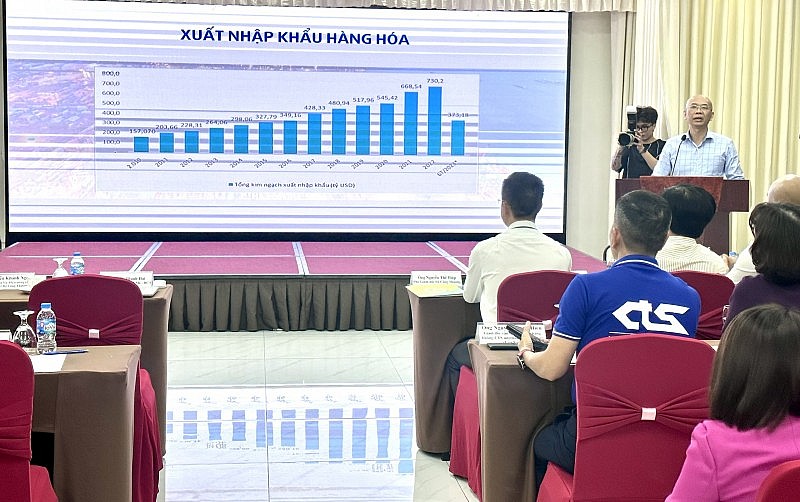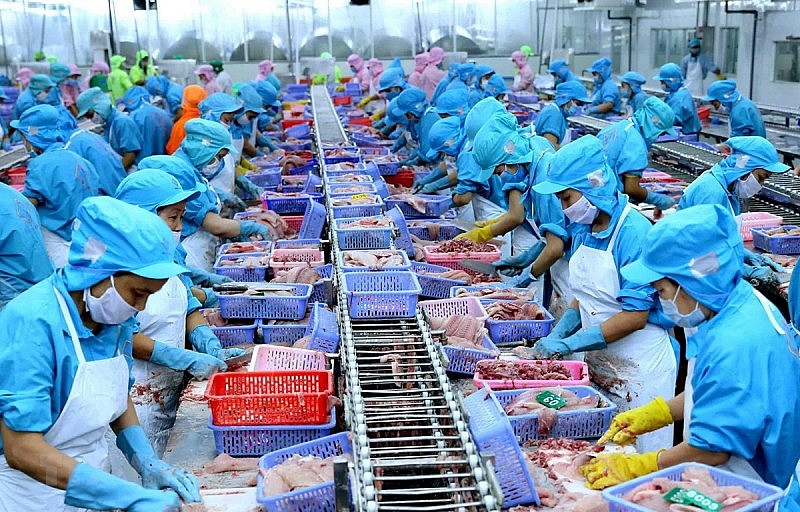 News
News
Vietnam's logistics services are lacking and weak
At the seminar "Logistics to promote industry linkages and enhance value chains" organized by the Hanoi Logistics Association in collaboration with the Hanoi Department of Industry and Trade held on the morning of June 28 in Hanoi, Mr. Tran Thanh Hai - Deputy Director of the Department Director of the Import-Export Department - Ministry of Industry and Trade said: Statistics of the World Bank (WB) show that Vietnam ranks 43/155 countries and territories on the LPI index (logistics efficiency index); according to Agility - Vietnam ranks 11/50 emerging logistics markets; According to statistics of the Vietnam Logistics Association (VLA), the growth rate is 14-16% with a scale of about 40-42 billion USD per year.
 |
| Mr. Tran Thanh Hai - Deputy Director of the Import-Export Department - Ministry of Industry and Trade said that Vietnam's logistics services are lacking leading enterprises. |
The figures of the General Statistics Office also show that there are 43,568 enterprises operating in the field of transportation and warehousing; there are 5,000 businesses providing 3PL (3rd party logistics) services. However, up to 95% of operating enterprises are small and medium enterprises.
Mr. Nguyen Thanh Hai assessed that up to now, most of Vietnam's logistics service enterprises only operate within the scope of the country. The number of Vietnamese enterprises that can go abroad - that is, establish businesses, become subsidiaries, have representative offices in foreign countries is very small. Meanwhile, there are many foreign enterprises coming to Vietnam to set up offices, branches, even companies with 100% foreign capital right in the field of logistics.
Since then, Mr. Hai acknowledged that Vietnam's logistics market is currently very narrow, so it is necessary to promote businesses to go out and look for markets outside. First of all, it can be the market of neighboring countries such as Laos, Cambodia, Myanmar to China, Thailand... These are all major trading partners of Vietnam.
In addition, the logistics infrastructure connected to the commercial and information technology infrastructure in both the country and the region is still not high. Service costs are still high, and the quality of some services is not high in the context that Vietnam's service supply market currently has stiff competition or lack of linkages between businesses in the industry.
Mr. Hai said that there is a shortage of large enterprises in the country, leading enterprises to create trends, create waves, and create orientations to attract and promote logistics services. in developed countries.
Logistics services for cold transport have not met the demand
Ms. Tran Hoang Yen - Deputy Head of the representative office of the Vietnam Association of Seafood Exporters and Producers (VASEP) said that the seafood industry is facing a big problem with the lack of cold storage, especially during peak times or when there is a shortage of cold storage. market difficulties.
In fact, frozen storage plays an indispensable role in the process of producing and supplying seafood, ensuring the quality of aquatic products. Even the storage conditions of cold storage determine the quality of seafood products.
Currently, most seafood enterprises have to invest in frozen storage to complete the process, but this capacity is usually only enough for the same business within a few days of production.
Moreover, the commercial warehouse and services for frozen seafood for import and export are mainly located in the South, while the North and the Central region are still limited.
Regarding transportation, a representative of VASEP said that in fact, the seafood industry is transported inland mainly by road, there are not many railways and waterways. Costs are high, many are incurred and this is a problem that all seafood businesses have recommendations.
 |
| Logistics services for cold transport of Vietnam have not met the demand, reducing the competitiveness of seafood exports. |
From the reality of this logistics service, Ms. Yen gives a comparative figure to clearly see that Vietnamese seafood export enterprises are suffering a disadvantage compared to foreign enterprises which are: Current selling price of shrimp of Vietnam is 2 USD/kg higher than that of India and 4 USD/kg higher than Ecuador's, which reduces the competitiveness of Vietnam's seafood exports, partly due to logistics services.
Mr. Nguyen Cong Cuong - Vice Chairman of Hanoi Association of Key Industrial Products Manufacturers (HAMI), Chairman of NCC Company, said that in the logistics system, road still accounts for the majority of goods transportation. chemical.
However, the development and maintenance of roads requires large investments in infrastructure and maintenance, from the construction of roads, bridges, and highways to the maintenance of the transport system. This cost is often passed on to consumers through freight rates, causing increased costs for logistics operations.
According to Mr. Cuong, the lack of synchronization in the transport system causes disruption and waste of time in the transportation process. Inadequacies such as traffic congestion, lack of infrastructure, unclear legal regulations, and management lead to increased time and cost of goods transportation.
As an enterprise operating in industrial production, Mr. Cuong assessed that the terminal infrastructure and roads also play an important role in the handling of goods and transportation.
However, this lack of infrastructure investment and maintenance can cause limitations and delays in the logistics process. Upgrading and improving infrastructure will require large investments and have an impact on logistics costs.
From this fact, associations and businesses all make suggestions and recommendations to help improve the current logistics system. Regarding the logistics system for seafood export, Ms. Tran Hoang Yen suggested that the Government should have a mechanism on land and incentives for medium and long-term capital to encourage domestic enterprises to invest more. for standard frozen storage and warehouse systems.
Strengthen capacity and capabilities of Vietnamese shipping service enterprises. Besides, Ms. Yen also suggested that, in the long term, the Government and localities need to invest more in logistics infrastructure of fisheries such as fishing ports, fish markets... This is the model of developed countries. seafood export development has been applied and very successful.